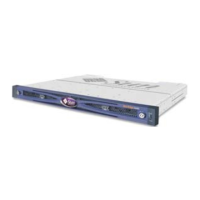Best Practices for the Sun StorEdge 3510 and 3511 FC Arrays 7
4 (host channels) x 1 (ID per channel) x 32 (LUNs per ID) = 128 maximum
addressable LUNs in a fabric point-to-point environment. If dual paths are
desired for each logical device, a maximum of 64 dual-pathed LUNs are available.
In an FC-AL configuration, multiple IDs can be assigned to any given host channel.
The maximum number of storage partitions that can be mapped to a RAID array is
1024. There are several ways that 1024 LUNs can be configured. For example:
4 (host channels) x 8 (IDs per channel) x 32 (LUNs per ID) =
1024 maximum addressable LUNs in a FC-AL environment.
However, configuring the maximum number of LUNs increases overhead and can
have a negative impact on performance.
The FC-AL protocol should be selected for environments needing more than 128
LUNs, or where a switched fabric network is not available.
Supported RAID Levels
There are several RAID level choices: RAID 0, 1, 3, 5, 1+0 (10), 3+0 (30), and 5+0 (50).
RAID levels 1, 3, and 5 are the most commonly used. The Sun StorEdge 3500 series
arrays support the use of both global and local spare drives in the unlikely event of
disk failure. It is good practice to use spare drives when configuring RAID devices.
Refer to the Sun StorEdge 3000 Family RAID Firmware User’s Guide for detailed
information about how RAID levels and spare drives are implemented.
Logical Drives
A logical drive (LD) is a group of physical drives configured with a RAID level. Each
LD can be configured for a different RAID level.
Sun StorEdge 3500 series arrays support a maximum of eight LDs. A LD can be
managed by either the primary or secondary controller. The best practice for creating
LDs is to add them evenly across the primary and secondary controllers. The most
efficient maximum configuration would have four LDs assigned to each controller.
With at least one LD assigned to each controller, both controllers are active. This
configuration is known as an active-active controller configuration and allows
maximum use of a dual controller array's resources.
Supporting large storage capacities requires using maximum-sized logical drives.
See
TABLE 2 and TABLE 4 to determine the maximum number of disk drives you can
include in a logical drive. The largest supported logical drive configuration is
determined by the size of your disk drives, cache optimization and the logical
drive’s RAID level (see
TABLE 3 and TABLE 5). Maximizing existing logical drives

